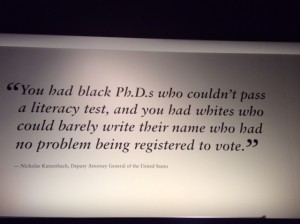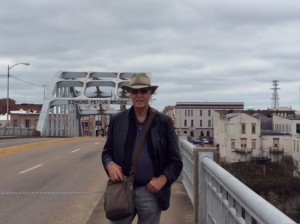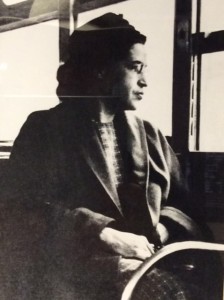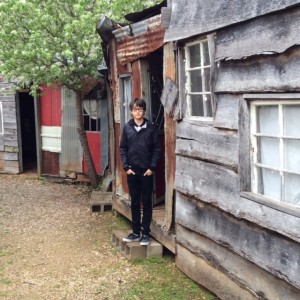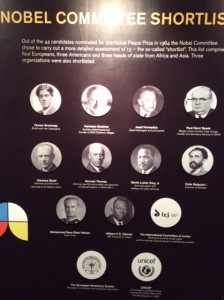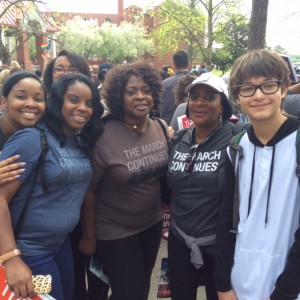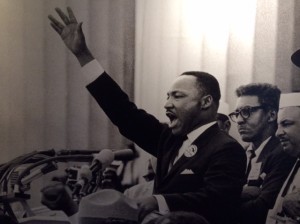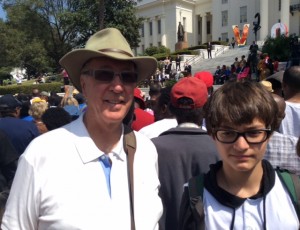Color Blind
The Selma-Montgomery March revisited – A Personal Journey
March 7-25, 1965 was a memorable period in the history of US race relations. It began with ‘Bloody Sunday’ when a group of marchers including Martin Luther King Jr. (“MLK”) crossed the Edmund Pettus Bridge in Selma and were viciously attacked by Selma police authorities. The march ended March 25 when some 25,000 marchers arrived at the steps of the Alabama State house and heard MLK deliver the famous “How long- Not Long” speech. As a 22 year-old student I had the privilege of participating in the historic final stages of those events.
Fifty years later – March 25, 2015 – I participated in the re-enactment of the march accompanied by my 14 year-old grandson Leo. Between those two dates in 1965 President Lyndon Johnson bowed to the pressure of the incredible events and images and announced support for the Voting Rights Act.
- Discrimination was at the heart of the problem and the vote is the basis of power in a democracy.
- 10 seconds before the start of Bloody Sunday
- Art on the infamous Edmund Pettus Bridge – the scene of Bloody Sunday. The bridge is named for a Confederate General and former Grand Dragon of the Ku Klux Klan – a fitting location for such a confrontation.
Reliving the events of 1965 was a searing reminder that in the 100 years following the end of the Civil War the life of the former slave population had hardly changed. I recall traveling through the American south in the 1950’s as a teenager. It was a world where every washroom, water-cooler, lunch counter and every other conceivable facility was color-coded. I had limited understanding of the implications since my skin allowed me a privilege that I had done nothing to deserve. In 1965 I attended College in Indiana – hardly the Deep South – but a College that attempted to be inclusive. Mixed with mid-western whites and possibly future Republicans were young women and men from Africa and the tough parts of Chicago. A delightful young woman from the south side of Chicago named Jan became a personal friend. I invited her to join me for a Valentine party and dance but she kept saying ‘No’. Finally she said – “Art – don’t you get it – the event is at a private golf club and they will deny me entry when I show up.” Remember, we were in northern Indiana rather than south of the Mason-Dixon Line.
I became part of a College group that had strong views on many controversial issues of the day. I was chair of the student group opposed to the election of Barry Goldwater. We marched and protested when the first American soldiers went to VietNam. The Civil Rights Movement was in full swing and became all-absorbing. We talked, held hands, sang protest songs and marched with or against anything that moved. There were consequences. The FBI was not amused and sent a report to Canada which took away my security clearance as well as my appointment to a diplomatic career with the Canadian Foreign Service. I suppose I should be grateful since it saved me from a life as a civil servant – I doubt I would have performed well limiting my views to the perspective of whatever Government was in power. (The US Government never forgets. It took the equivalent of Divine Intervention to acquire my NEXUS pass).
- Rosa Parks who started it all in 1955 by insisting on her seat on a Montgomery bus!
- A small part of one of the many marches during the height of the Civil Rights era. The number and persistence of marchers gave the leaders the power to demand change.
The Civil Rights era changed America but also had a profound impact on people like myself. I made visits to Koinonia Farm, an intentional inter-racial community near Americus, Georgia founded by theologian Clarence Jordan in 1942. This community was hardly popular in the Deep South and experienced violence and boycotts. Its unique program and existence attracted many people trying to find their way through the American tragedy. One such person was Millard Fuller, the millionaire lawyer and entrepreneur from Montgomery, Alabama who opted for voluntary poverty and activism. He would become the founder and charismatic leader of Habitat for Humanity, a global leader in housing for the poor. I met Fuller when he arrived at Koinonia and we debated whether a Christian could be in business or needed to be a radical activist. He was a factor in my moving to an international career starting in Bangladesh in 1972. Fuller changed the world in his way while I entered business and have attempted to use my skills and influence to change the world from inside that perspective. The original law partner of Fuller would later initiate the legal case that destroyed the Ku Klux Klan plus lead the effort to build the moving Museum of Civil Rights in Montgomery. While there were many leaders of the movement – a few people always play an extraordinary role.
- Leo exploring the collection of third world shacks assembled at the Habitat for Humanity Global Village Museum in Americus. A personal note: Habitat operates ReStore outlets to recycle building materials in over 800 locations and provides an annual income in the hundreds of millions to Habitat for Humanity. The very first location for ReStore was a Palliser warehouse in Winnipeg. I cannot take any credit for thinking of the idea but am pleased that our company and some of our people could play a role in starting this remarkable venture.
- Nobel Committee documents made public after 50 years. To think that Martin Luther Kling was in competition with Mohammad Reza Shah Pahlavi – the repressive Shah of Iran for the Nobel Peace Prize!
Jimmy Carter was literally a neighbor to Koinonia and later together with Rosalynn became the very effective spokesperson for Habitat for Humanity. Carter was influenced by these experiences and through his work at the Carter Center in Atlanta – which won the Nobel Peace Prize – became undoubtedly the best ex-President of the USA. Leona and I had the privilege to work with Jimmy and Rosalynn on several of the weeklong special Habitat ‘builds’.
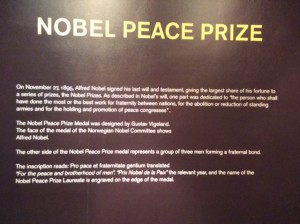
The Nobel Peace Prize was awarded to Jimmy Carter and the Carter Center for their work in building Peace and Democracy. Two Nobel awards out of the same set of problems and small community.
Another memorable contact from those years was Joan Baez. I attended the Washington concert where she was turfed out of the auditorium of the “Daughters of the American Revolution” hours before her concert and instead was allowed to sing from the Washington Memorial to a much larger crowd. At the time Baez was plying her trade in the cafés of Harvard Square where I was a student. Years later I would attend a UN Conference about Cambodia in Geneva with Baez and a couple of others (See Weekend in Geneva in my Website) where I wrote the paper and she wrote the songs and we did alter a UN resolution.
The return to the events and roads of the Selma-Montgomery March should have been a celebration and in many ways it was. On the current march we visited with young professional black women who stated their careers would not have been possible without the events of that earlier period. We visited Lowndes County on the road between the two cities. In 1965 Lowndes had 5,000 eligible potential black voters but zero were registered to vote. Selma had 15,000 potential voters but after years of some of the most effective and persistent efforts to register voters – only 200 had succeeded. In 1965 the crowd of 25,000 marched to the foot of the Alabama Statehouse steps and MLK gave his powerful speech from the back of a flatbed truck because the march did not have authority to touch the statehouse property. In 2015 the same truck was in place – but symbolically drove away to reveal the assembled dignitaries including the current Governor speaking from the impressive steps. In 1965 Governor George
Wallace ostensibly watched the events from an upper floor window. In 2015 the daughter of Wallace followed the speech by the daughter of MLK with what was in effect an apology – “My father was on the wrong side of History”.
- From tenant farmer parents in Lowndes County to College degrees in one generation. They know who to thank for the changes.
- There were no smiles on the walk 50 years ago.
- The mayor of Montgomery was all over the march and pleased to pose with Leo – who is impressed my important people. The woman in red is Congresswoman Terri Sewell, the first black woman ever elected to Congress from Alabama. She is a grad of Princeton, Oxford and Harvard Law – I suspect could beat most others in Congress on educational qualifications! She gave me a hug and said it was because of all of us who were involved 50 years ago that allowed her to be elected today.
The last word was given to Morris Dees – the lawyer and former partner of Millard Fuller. Dees was vintage southern orator and reminded the crowd and assembled authorities that the battle was not over. With the current Republican Governor sitting a few steps away he pointed to the Statehouse:
“These legislators have recently passed laws that will restrict voting for blacks and minorities.”
Rather symbolically the US Supreme Court had that very morning declared some of those changes to the law unconstitutional! He then referred to the efforts to restrict Healthcare for poor people, Medicaid for the old and much more. Close my eyes and it was vintage 1965 – but the truth.
My 14 year-old grandson was introduced to practices and events that were new and shocking for him. He lives in Ontario and stated that in his school with a multicultural student body he had never experienced events or attitudes that reflected negatively on race – can he only remain so innocent and that be the real world. The experience caused me to reflect on my life living with a family that includes visible minority children and work in countries with diverse races, colors and problems. I recalled that phone call to Jan over 50 years ago. I remember that I could see her features, her winning smile, her intense eyes – but I could not see the color she was referring to. Obviously I see color! That was an insight that has remained with me. When we meet a person and they begin to become someone with personality, competence and most important a name – color tends to disappear.
May we all become Color-Blind.
P.S. I returned from the 1965 march as a much less innocent person and wrote a poem titled In His Steps. An abridged version is the oldest entry on my website and located in the category “Stories and Reflections”.Blog

